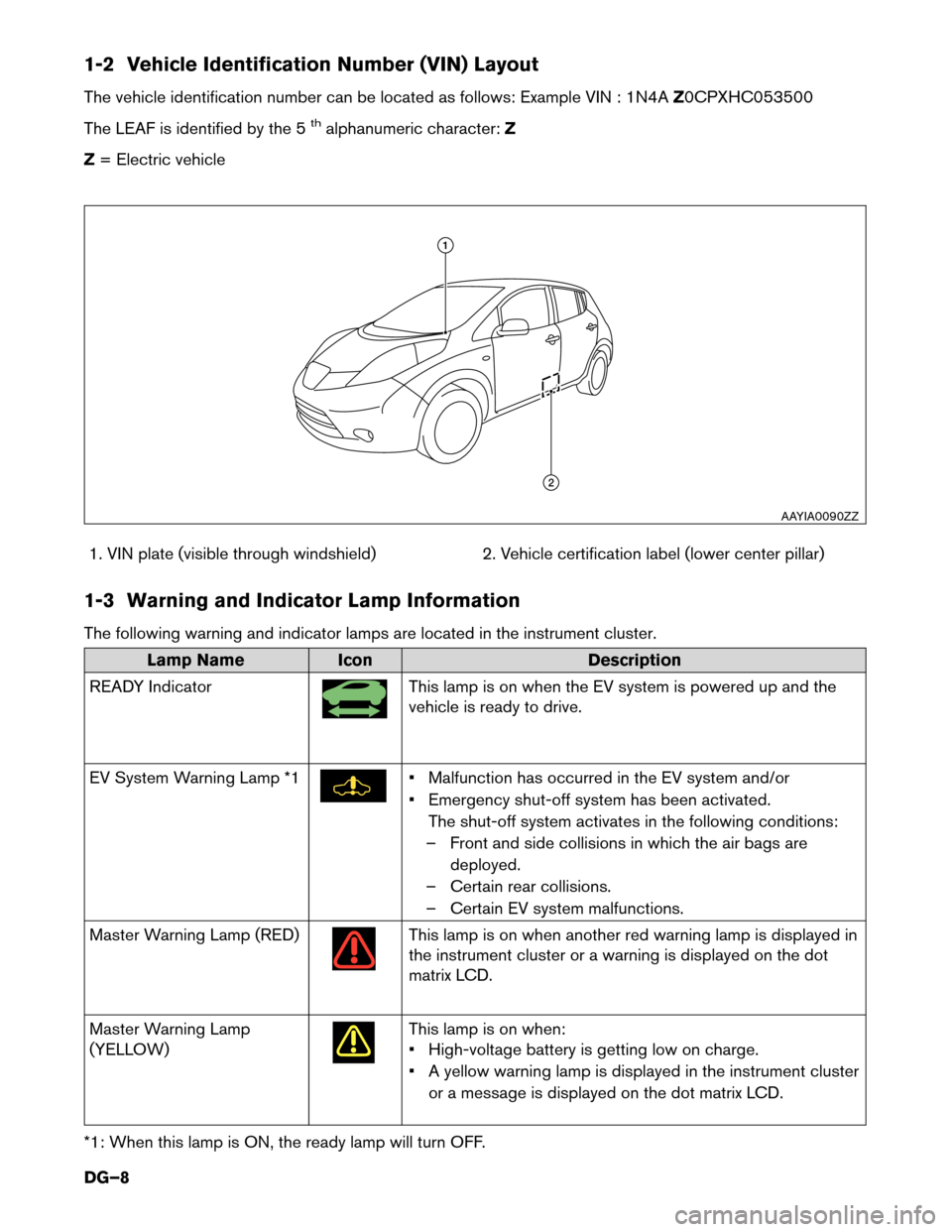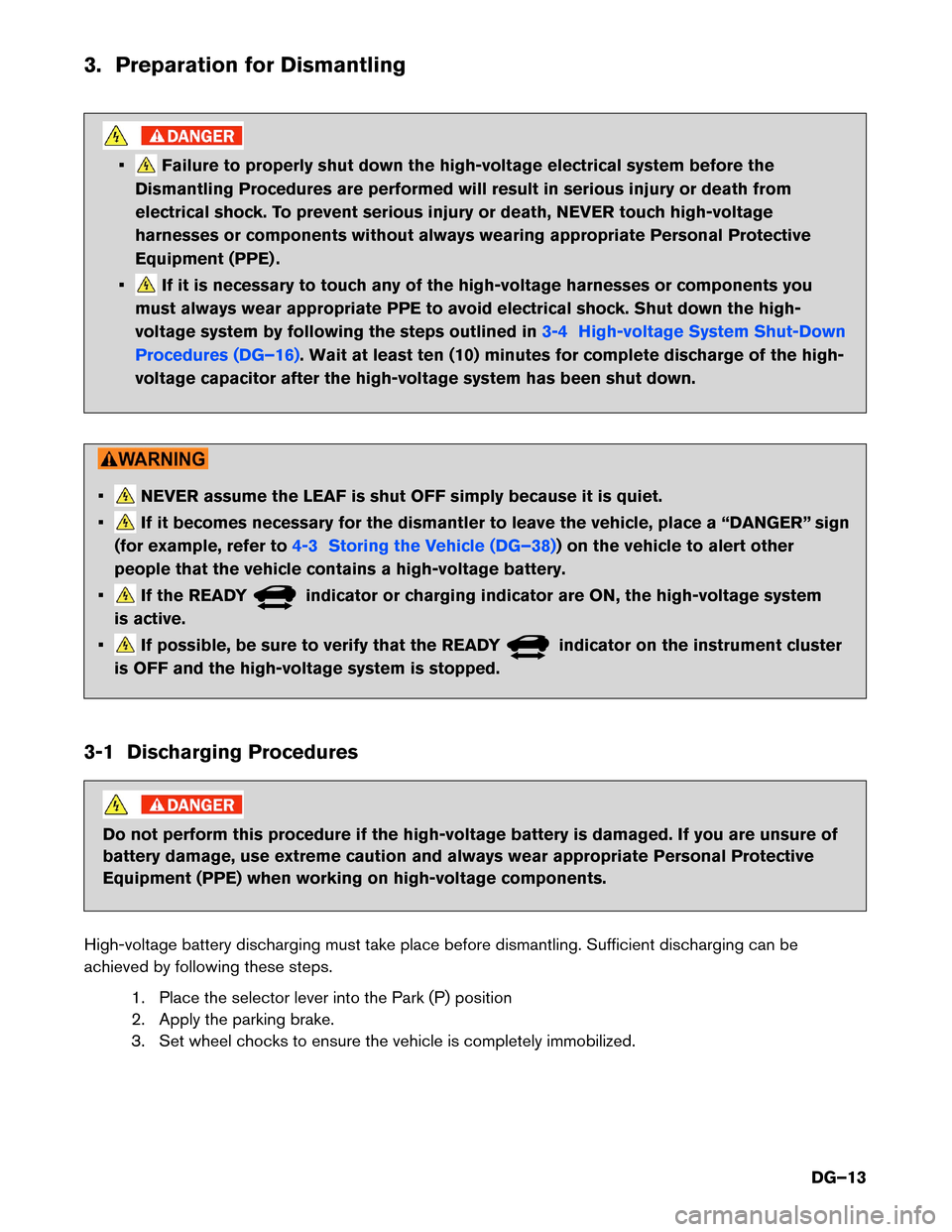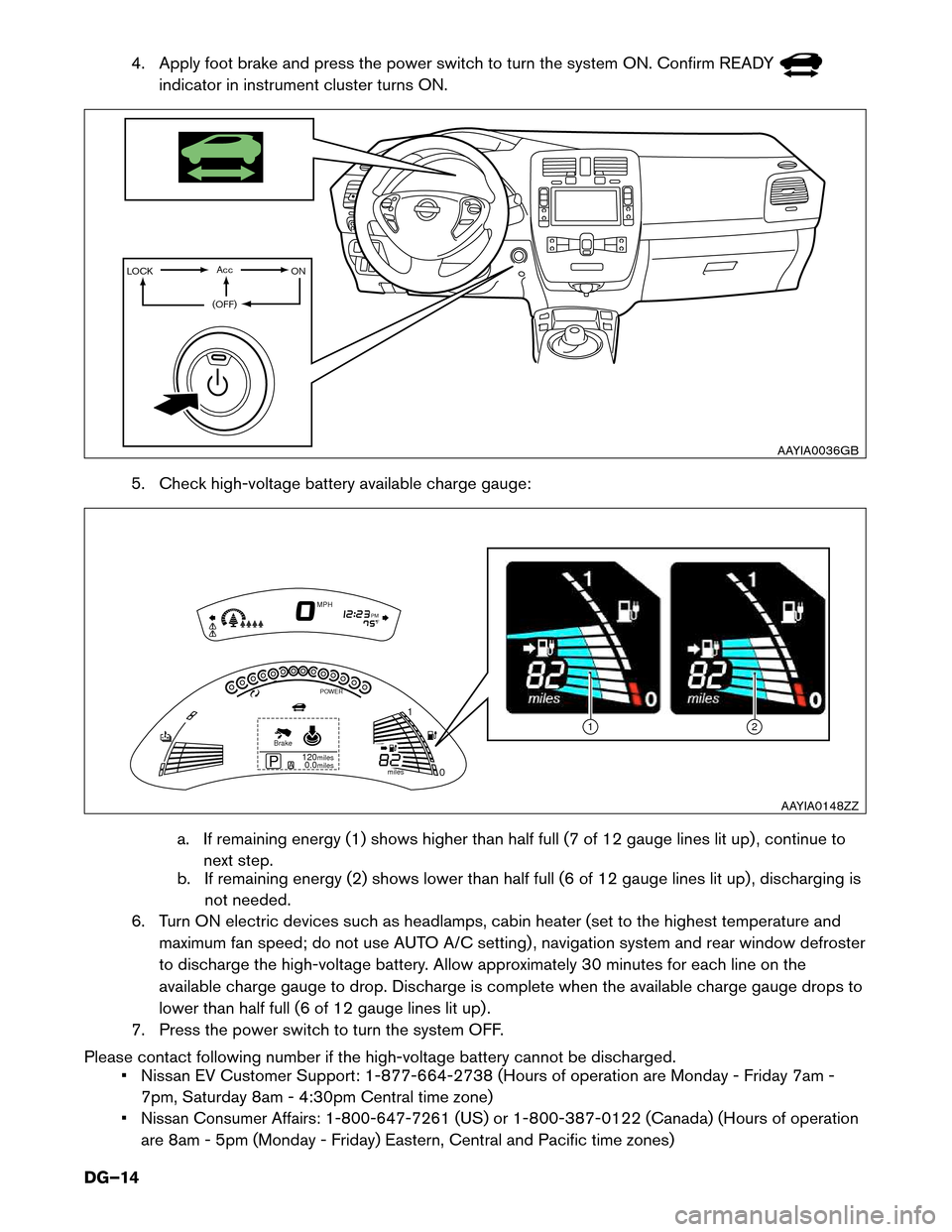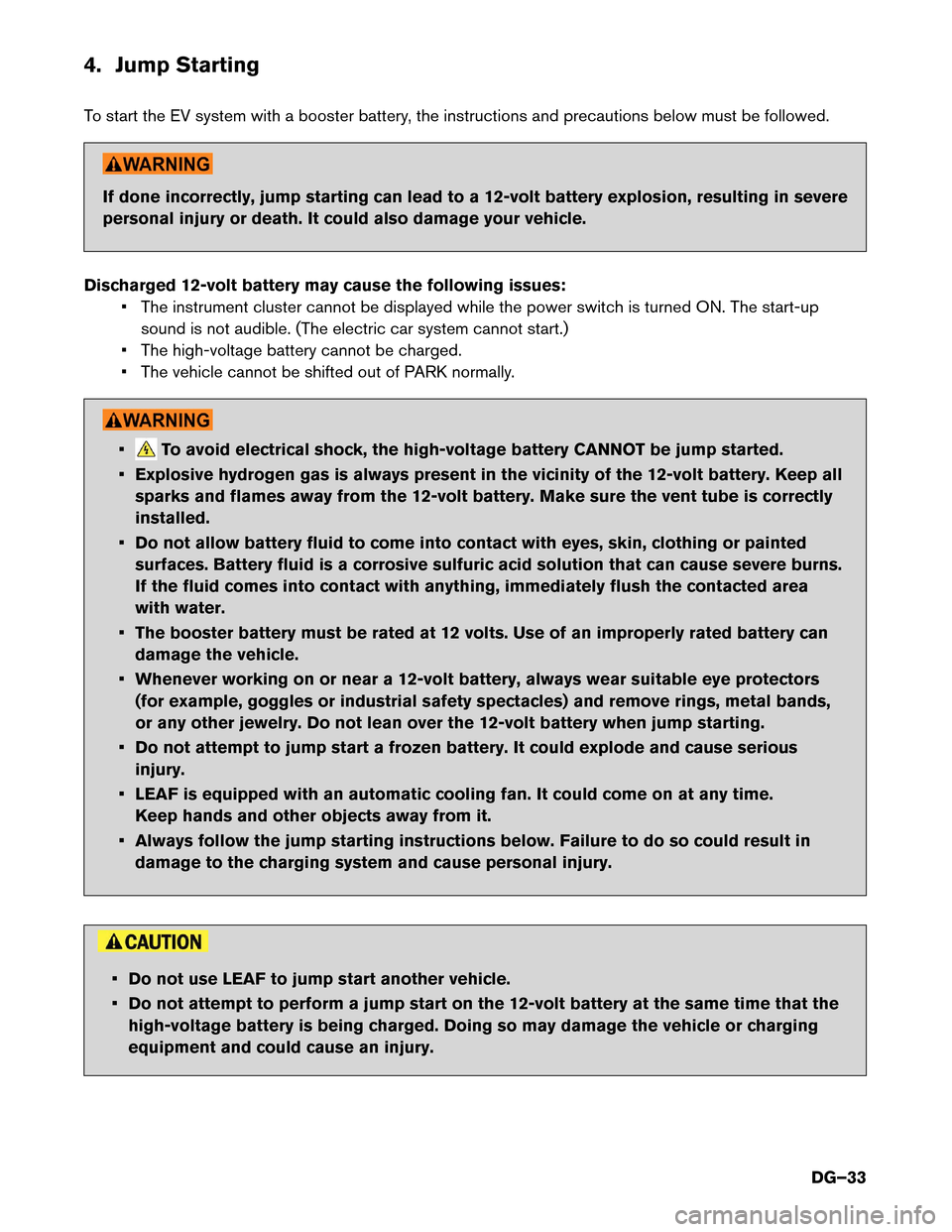Page 8 of 48

1-2 Vehicle Identification Number (VIN) Layout
The
vehicle identification number can be located as follows: Example VIN : 1N4A Z0CPXHC053500
The LEAF is identified by the 5
thalphanumeric character: Z
Z = Electric vehicle
1. VIN plate (visible through windshield) 2. Vehicle certification label (lower center pillar)
1-3 Warning and Indicator Lamp Information
The following warning and indicator lamps are located in the instrument cluster. Lamp Name
Icon Description
READ
Y Indicator This lamp is on when the EV system is powered up and the
vehicle
is ready to drive.
EV System Warning Lamp *1 • Malfunction has occurred in the EV system and/or
•
Emergency shut-off system has been activated.
The shut-off system activates in the following conditions:
– Front and side collisions in which the air bags are deployed.
– Certain rear collisions.
– Certain EV system malfunctions.
Master Warning Lamp (RED) This lamp is on when another red warning lamp is displayed in
the
instrument cluster or a warning is displayed on the dot
matrix LCD.
Master Warning Lamp
(YELLOW) This lamp is on when:
•
High-voltage battery is getting low on charge.
• A yellow warning lamp is displayed in the instrument cluster or a message is displayed on the dot matrix LCD.
*1: When this lamp is ON, the ready lamp will turn OFF. 1
2
AAYIA0090ZZ
DG–8
Page 13 of 48

3. Preparation for Dismantling
• Failure to properly shut down the high-voltage electrical system before the
Dismantling Procedures are performed will result in serious injury or death from
electrical shock. To prevent serious injury or death, NEVER touch high-voltage
harnesses or components without always wearing appropriate Personal Protective
Equipment (PPE) .
• If it is necessary to touch any of the high-voltage harnesses or components you
must
always wear appropriate PPE to avoid electrical shock. Shut down the high-
voltage system by following the steps outlined in 3-4 High-voltage System Shut-Down
Procedures
(DG–16) . Wait at least ten (10) minutes for complete discharge of the high-
voltage
capacitor after the high-voltage system has been shut down. • NEVER assume the LEAF is shut OFF simply because it is quiet.
• If it becomes necessary for the dismantler to leave the vehicle, place a “DANGER” sign
(for
example, refer to 4-3 Storing the Vehicle (DG–38)) on the vehicle to alert other
people
that the vehicle contains a high-voltage battery.
• If the READY indicator or charging indicator are ON, the high-voltage system
is
active.
• If possible, be sure to verify that the READY indicator on the instrument cluster
is
OFF and the high-voltage system is stopped.
3-1 Discharging Procedures Do not perform this procedure if the high-voltage battery is damaged. If you are unsure of
battery
damage, use extreme caution and always wear appropriate Personal Protective
Equipment (PPE) when working on high-voltage components.
High-voltage battery discharging must take place before dismantling. Sufficient discharging can be
achieved by following these steps. 1. Place the selector lever into the Park (P) position
2. Apply the parking brake.
3. Set wheel chocks to ensure the vehicle is completely immobilized.
DG–13
Page 14 of 48

4. Apply foot brake and press the power switch to turn the system ON. Confirm READY
indicator in instrument cluster turns ON.
5. Check high-voltage battery available charge gauge: a. If remaining energy (1) shows higher than half full (7 of 12 gauge lines lit up) , continue to next step.
b. If remaining energy (2) shows lower than half full (6 of 12 gauge lines lit up) , discharging is
not needed.
6. Turn ON electric devices such as headlamps, cabin heater (set to the highest temperature and
maximum fan speed; do not use AUTO A/C setting) , navigation system and rear window defroster
to discharge the high-voltage battery. Allow approximately 30 minutes for each line on the
available charge gauge to drop. Discharge is complete when the available charge gauge drops to
lower than half full (6 of 12 gauge lines lit up) .
7. Press the power switch to turn the system OFF.
Please contact following number if the high-voltage battery cannot be discharged. • Nissan EV Customer Support: 1-877-664-2738 (Hours of operation are Monday - Friday 7am -
7pm, Saturday 8am - 4:30pm Central time zone)
•
Nissan Consumer Affairs: 1-800-647-7261(US) or 1-800-387-0122 (Canada) (Hours of operation
are 8am - 5pm (Monday - Friday) Eastern, Central and Pacific time zones) LOCK Acc
(OFF) ON AAYIA0036GB
0
1 POWER
Brake
P A 120miles
0.0miles MPH
PM
F miles 1 2
AAYIA0148ZZ
DG–14
Page 33 of 48

4. Jump Starting
T
o start the EV system with a booster battery, the instructions and precautions below must be followed. If done incorrectly, jump starting can lead to a 12-volt battery explosion, resulting in severe
personal
injury or death. It could also damage your vehicle.
Discharged 12-volt battery may cause the following issues: • The instrument cluster cannot be displayed while the power switch is turned ON. The start-upsound is not audible. (The electric car system cannot start.)
• The high-voltage battery cannot be charged.
• The vehicle cannot be shifted out of PARK normally. • To avoid electrical shock, the high-voltage battery CANNOT be jump started.
•
Explosive hydrogen gas is always present in the vicinity of the 12-volt battery. Keep all
sparks and flames away from the 12-volt battery. Make sure the vent tube is correctly
installed.
• Do not allow battery fluid to come into contact with eyes, skin, clothing or painted surfaces. Battery fluid is a corrosive sulfuric acid solution that can cause severe burns.
If the fluid comes into contact with anything, immediately flush the contacted area
with water.
• The booster battery must be rated at 12 volts. Use of an improperly rated battery can damage the vehicle.
• Whenever working on or near a 12-volt battery, always wear suitable eye protectors (for example, goggles or industrial safety spectacles) and remove rings, metal bands,
or any other jewelry. Do not lean over the 12-volt battery when jump starting.
• Do not attempt to jump start a frozen battery. It could explode and cause serious injury.
• LEAF is equipped with an automatic cooling fan. It could come on at any time. Keep hands and other objects away from it.
• Always follow the jump starting instructions below. Failure to do so could result in damage to the charging system and cause personal injury. • Do not use LEAF to jump start another vehicle.
•
Do not attempt to perform a jump start on the 12-volt battery at the same time that the
high-voltage battery is being charged. Doing so may damage the vehicle or charging
equipment and could cause an injury.
DG–33